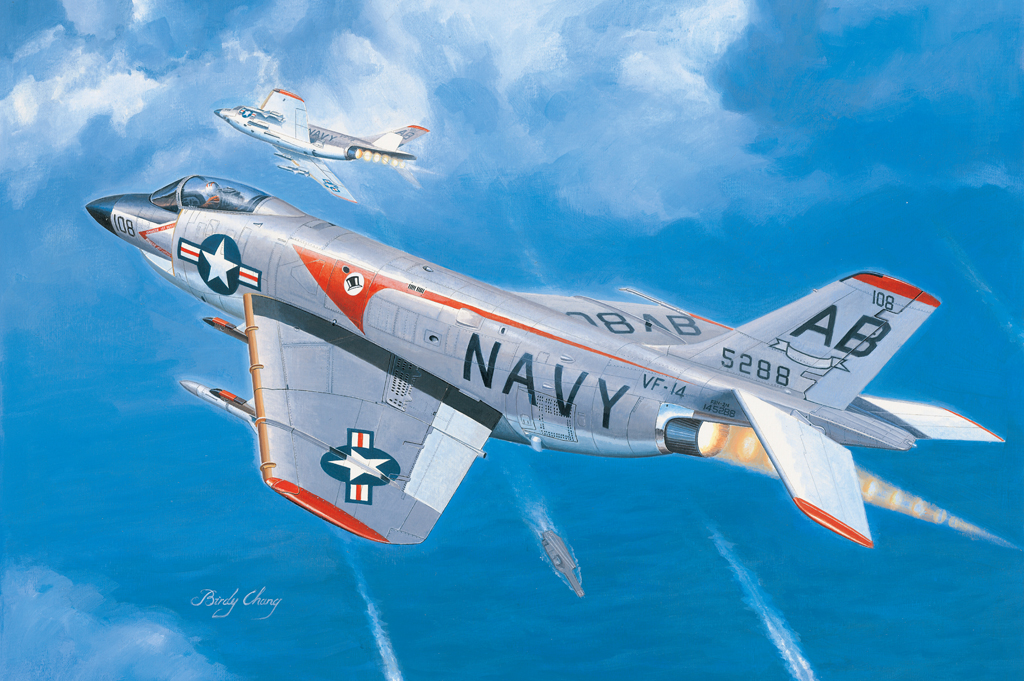
Demons had a very active career, seeing combat duty
around Quemoy and off the Lebanon in 1958. Last deliveries took place in 1959
and replacement by the McDonnell F-4 was complete by August 1964 (first line)
and February 1965 (reserve),
In service, the Demon performed dependably and gained
praise from pilots for its stable flying characteristics, at high altitude as
well as during carrier operations. Between 1956 and 1964, a total of 23 US Navy
‑ fighter squadrons flew versions of the F3H Demon. The type was withdrawn
before it could serve in Vietnam, where the F-4 Phantom II, itself conceived as
an advanced development of the Demon, was a mainstay.
The F3H Demon was the first swept-wing jet fighter aircraft
built by McDonnell Aircraft and also the first aircraft designed to be armed
only with missiles rather than guns. The carrier-based, transonic, all-weather
Demon fighter was designed with the philosophy that carrier-based fighters need
not be inferior to land-based fighters. However, the planned powerplant, the
new J40 turbojet, failed to meet its expectations and left early Demons
(F3H-1N) underpowered. Production delays were also caused by the Navy’s desire
for the Demon to be an all-weather nightfighter. And so, although the prototype
had flown in August 1951, the radar-equipped Demon did not enter service until
March 1956 as the F3H-2N and then with the Allison J71 turbojet as the
powerplant.
By the time production ceased in 1959, 519 Demons had been
built including the definitive Demon fighter-bomber (F3H-2). At its peak US
Navy use, the Demon equipped 11 squadrons.
Beyond doubt McDonnell’s most trying programme-due to
circumstances outside their control-was the F3H Demon. Like all the company’s
jets so far it was designed around an axial engine from Westinghouse. In this
case it was the huge J40, on which virtually all the Navy’s plans for fighters
and bombers rested in the late 1940s. The XE3H-1 Demon was ordered in 1948 as a
carrier-based fighter equal in performance to land-based machines. The result,
flown on 7 August 1951, was even more advanced than the Voodoo, though the
family likeness was obvious. The wing had a different form, though just as much
sweep. To facilitate carrier operation, the wing was broader and liberally
endowed with slats and flaps. The tail was fully swept and the horizontal
surfaces were single-piece slabs. The main undercarriage had an extremely wide
track, while the J40 engine was fed by lateral inlets and discharged under the
tail, occupying the space which in the XF-88 had mainly been fuel.
After four disastrous years, the Navy had to abandon the J40
in early 1954 and reshape or abandon its aircraft programmes. Though 60 F3H-1
Demons were delivered as instructional airframes, the company managed to rescue
the programme with the Allison J71-A-2, rated at 6,470 kg (14,2501b) with full
afterburner. With the inevitable delay, McDonnell redesigned the Demon as an
all-weather missile-armed interceptor.
The F3H Demon was what might be called a mature design for a
shipboard fighter. It had swept wings from the start (unlike Grumman’s F9F),
a single pilot and just one engine (when many recent designs had featured two
or even four, such was the low thrust rating of many early turbojets). First
prototype XF3H-1 125444 ‑ flew from Lambert Field on 7 August 1951, under the
power of a non-afterburning J40-WE-6. Early ‑ flight testing with the two
prototypes, which saw the loss of 125444, only confirmed that the J40 had
serious reliability problems and left the aircraft under-powered. Even before
this time, the US Navy had ordered the Demon into production, although as the
night fighter F3H-1N rather than the planned day fighter. Engine failures
and crashes plagued early production F3H-1Ns, leading to a grounding of all
F3Hs in the spring of 1954. With no confidence that Westinghouse would ever
manage to resolve the J40’s problems, the Navy took the decision to re-engine
the F3H, its choice falling on the Allison J71.
No F3H-1 ever reached squadron service, although several
were issued for ground training purposes. There was then a delay in the
programme until the re-engined F3H-2N became available; two F3H1Ns modified to
fit the J71 ‑ flew in January 1955 and production F3H-2Ns started to come off
the line three months later. Acceptance testing progressed to carrier trials
aboard USS Ticonderoga in September 1965, and deliveries were made to the first
front-line squadron, VF-14 `Top Hatters’ at Cecil Field, FL, in April 1956.
VF-14 undertook a shake-down cruise aboard USS Forrestal early the following
year, by which time further units were taking delivery. In service, the
aircraft proved rugged, nimble (`we outturn anything’) and well adapted to
carrier operations. Better it was marginally supersonic in level flight. The
Demon had a flight refuelling probe, semi-retractable, on the starboard
forward fuselage. In Operation `Pipeline’ in May 1958, VF-64 flew four
aircraft non-stop across the Atlantic, thus underlining the US Navy’s ability
quickly to reinforce its carrier-embarked Air Wings by ferrying aircraft from
east coast air stations to its Sixth Fleet aircraft carriers in the
Mediterranean.
The F3H-2 entered service aboard US Navy carriers in 1957 as
the most advanced combat aircraft then to have put to sea. Altogether 519 were
delivered, most being F3H-2 strike fighters but final batches comprising 79
F3H-2M missile platforms with the A1M-7C Sparrow and 146 being F3H-2N night and
all-weather fighters with different radar and AIM-9C Sidewinders. All versions
saw extensive active service, including combat air patrols over Quemoy, Formosa
and the Lebanon in 1958. These aircraft were redesignated F-3B, MF-3B and F-3C
in 1962.
Specifications: McDonnell F3H-2 Demon
First flight: August 7,1951 (XF3H-1)
Power: Allison 6350kg/14,0001b afterburning thrust J71-A-2E
turbojet
Armament: Four 20mm/0.78in cannon and four AIM-7C Sparrow AAMs
Size: Wingspan – 10.77m/35ft 4in
Length — 17.96m/58ft 11 in
Height – 4.44m/14ft 7in
Wing area – 48.22m2/519sq ft
Weights: Empty -10,039kg/22,1331b
Maximum take-off – 15377kg/33,9001b
Performance: Maximum speed — 1041 kph/647mph
Ceiling – 13,000m/42,650ft
Range – 2205km/1370 miles
Climb – 3660m/12,000ft per minute